#rollo duke of normandy
Text
Never mess with Frank Ladies...
and above all, with their beloved husbands.


Headcanon of mine: Empress Frederuna was a calm and collected woman, but whenever someone talked bad about her beloved family, she used to lose her sh*t... Just like her daughter Gisla xD!
(Sorry for the very, very bad quality of the second gif: when i have time, i shall modify it with a better one, i promise!)
Credits to the History Channel tv shows Vikings and Knightfall.
#vikings#vikings charles#vikings gisla#vikings rollo#vikings frederuna#emperor charles#empress frederuna#rollo duke of normandy#gisla princess of frankia and duchess of Normandy#charlesxfrederuna#rolloxgisla#like mother like daughter#never mess with frank ladies and their husbands xD
7 notes
·
View notes
Text
Rollo, the legendary Viking warrior, invaded France and laid siege to Paris more than once. In the end, the French made peace with him and he was allowed to start a dynasty in the area known as Normandy today.
#Rollo#Duke of Normandy#Ragnar Lothbrok#Viking leader#West Francia#paris#Siege of Paris#Burgundy#Dudo of Saint-Quentin#Carolingian Empire#Charlemagne#ancient#history#ancient origins
36 notes
·
View notes
Text
A Thing Of Vikings Chapter 129: And A Warm Embrace

Chapter 129: And A Warm Embrace
During the periods of the Kingdoms of Francia, Brittany (Breton: Breizh), in its position occupying the westernmost peninsula of the region, was regarded as a stubborn outsider—culturally Brythonic Celtic instead of Gallo-Roman, with a different and distinct language, identity, and historical background. Beginning as independent petty kingdoms formed by displaced Celts from the Anglo-Saxon invasion of Britain, Brittany spent the next few centuries fully independent, occasionally joining forces with the Roman Empire against the likes of Attila the Hun, but otherwise being mostly occupied with domestic political matters and associating with their fellow Celtic nations in the Isles, occasionally sending reinforcements to the Cymru, Picts, Kernowyon, and Gaels as they fought against the Anglo-Saxon invaders.
Later, in the 9th century AD, Brittany became a tributary suzerain state to the Carolingian Empire under Emperor Charlemagne, who managed to impose vassalhood on the region, reducing the Breton lords to semi-autonomous status. This did not last long, however, as in the aftermath of Charlemagne’s death, they rebelled against the Carolingians, securing their independence as a unified kingdom of Brittany in 851 AD after defeating Charles the Bald at the Battle of Jengland. From there, they proceeded to expand their kingdom at Francian expense, taking large swaths of territory around the eastern extents of their peninsula, and reaching their greatest territorial extent in 867 AD.
Internal political disputes ensued, stopping the kingdom’s expansion, and rendering it ripe for conquest by Viking raiders in the early 900s; by 919 AD, the entire kingdom was fully occupied by Norsemen, who looted and pillaged many cities and monasteries without facing organized resistance. The region was eventually liberated from the Norse occupiers by Alan “Twistedbeard” II, grandson of King Alan the Great, the prior king of Brittany, between 935 and 939, culminating in an attack on the last Norse stronghold at Trans-la-Fôret by joint Breizh and Frankish forces. Meanwhile, to the neighboring east on what had once been part of the kingdom of Brittany, Rollo the Viking had settled in with his own men, offering allegiance to King Charles the Simple in exchange for claim to what would become known as the Duchy of Normandy.
With his lands in ruin from decades of war and looting, Alan could not hope to restore his prior kingship and likewise made the same decision as Rollo had, offering tribute to King Louis IV of Francia in 942 AD as the Duke of Brittany. This action ended Brittany’s time of independence and politically brought it into the Kingdom of Francia as the Duchy of Brittany. However, the newly-born duchy still had a long independent history and a cultural identity as separate from the rest of the kingdom…
—A History of Old Francia, 1432, Oxford Press
AO3 Chapter Link
~~~
My Original Fiction | Original Fiction Patreon
8 notes
·
View notes
Text
Marcellus Rollosson
Prince of Normandy, destined to fight and die as Lothbrok and be a Viking.


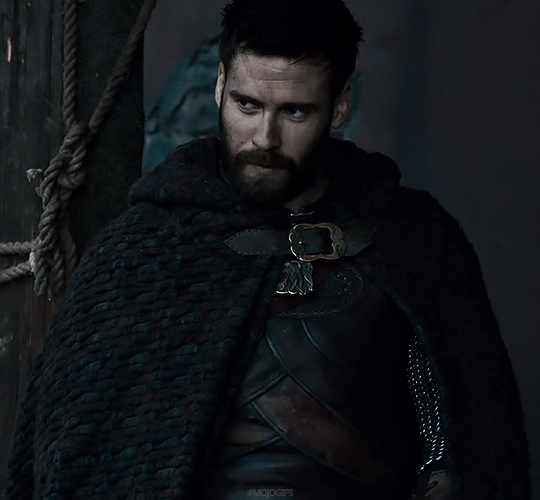

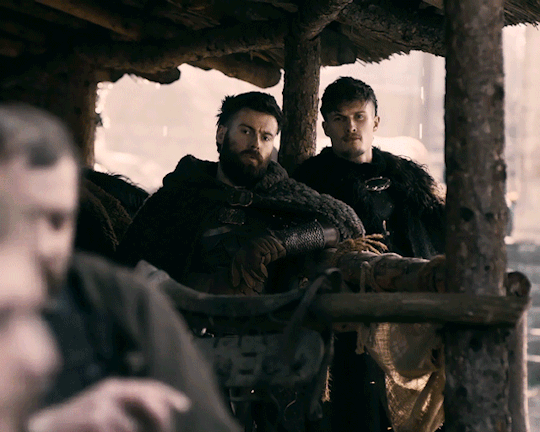
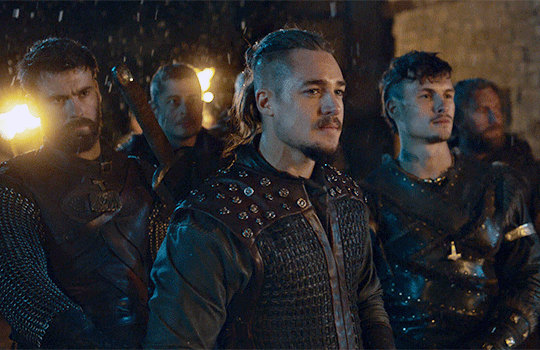
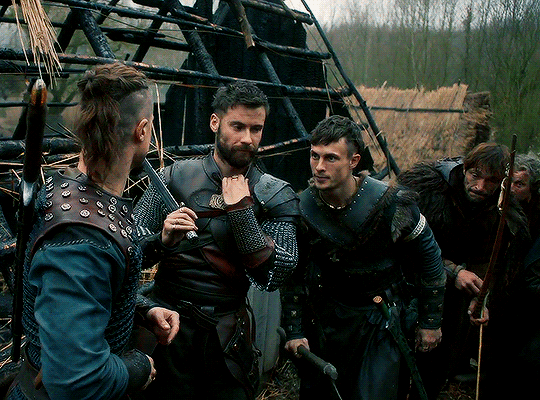
Marcellus of Normandy or Rollosson is the second-born son of Duke Rollo and Duchess Gisla, William's younger brother and the older brother of Celsa and Prince of Normandy. He is also the nephew of Ragnar Lothbrok and cousin of Bjorn, Ubbe, Hvitserk, Sigurd and Ivar. Although the Frankish Empire suffered significant losses as a result of Ragnar's attacks on Paris and the young Frank quickly learned to view any threat to Paris and especially the Vikings as mortal enemies and to destroy them to the bitter, bloody end, Marcellus admired his uncle and the Viking streak his father, because despite his baptism and Christian faith, he takes after his father and is a true Viking through and through. Which is why he often quarrels with his family and is especially not accepted by his mother and is seen as a disgrace in the royal family. He is also at war with his older brother, who sees his little brother as a threat to Paris, as disloyal, not worthy of the family and as a threat to the throne. While Marcellus, unlike his brother, is raised as a true warrior, a Viking, Rollo's pride advises him to follow his true fate and faith and learns brutal fighting from his father. His name also means young warrior, which over time he becomes strong, unstoppable and strong. In order to follow his true destiny, he wants to set off for Kattegat, to his father's roots, his roots and is rejected by his mother. Nevertheless, he encourages him to do the right thing and, regardless of the losses, his father helps him escape. Despised by his family and without a home, he tries to gain a foothold in Kattegat, to get closer to his family and to prove himself as a man of the family, the Lothbroks, in battle and as different from his father. Because even if Marcellus is a Viking, regardless of the fight and in every battle, he is different from his father. Marcellus is neither greedy nor does he want anything for himself or is envious; he is charming, has a clever and strong sense of humor and is always bright and helpful. A man of his word, who is loyal to those he chooses, goes into every battle, no matter how hopeless, and stands his ground, warmly and full of good nature and also wants to defend the name Lothbrok and do it all honor. Now he not only fights for Kattegat and his family and as a Viking but also sees Cailan, Vidar and Illian as his brothers, behind whom he stands faithfully and loyally. [ born as Prince of Normandy and now a true Viking and warrior as part of the Lothbrok family. Vikings ]
13 notes
·
View notes
Photo
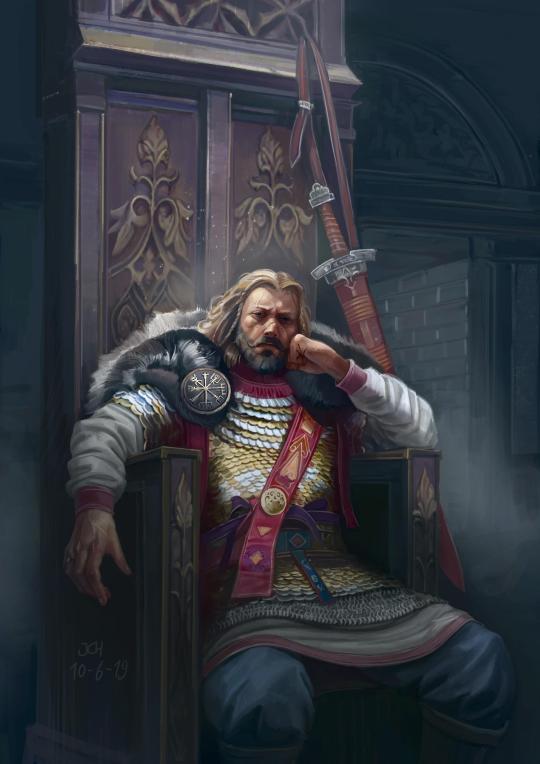
Rollo, Duke of Normandy by Joel Chaim Holtzman via ImaginaryNobles
73 notes
·
View notes
Text
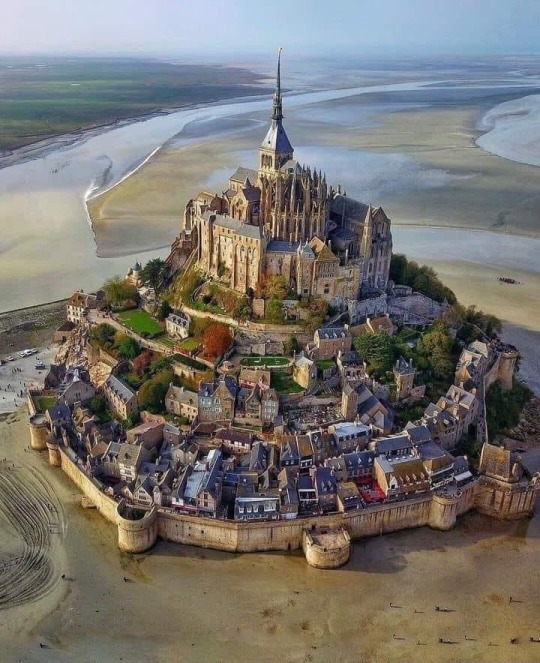
🇫🇷 Le Mont-Saint-Michel (pronounced [mɔ̃ sɛ̃ mi.ʃɛl]; English: Saint Michael's Mount) is an island and commune in Normandy, France. It is in the Manche department. It is located about one kilometre (0.6 miles) from the country's northwestern coast. It is at the mouth of the Couesnon River near Avranches. It is 247 acres (100 ha) in size and it has a population of 44 (2009). People that live there are called the Montois. The island has had strategic fortifications since ancient times. The name Mont-Saint-Michel comes from the monastery built there in the eighth century AD. The way in which the town is built is an example of how feudal society worked. At the top there is God, the abbey and monastery. Below this, there are the great halls, then stores and houses. At the bottom, outside the walls, there are the houses of fishermen and farmers.
Mont-Saint-Michel is one of France's most famous landmarks. The island and its bay are part of the UNESCO list of World Heritage Sites. Every year, more than 3 million people visit it.
History
Mont-Saint-Michel was an Armorican stronghold of Gallo-Roman culture in the sixth and seventh centuries. In the seventh century, the Franks took the mount. From about the fifth to the eighth century, Mont-Saint-Michel was part of a region called Neustria. At the start of the ninth century, it was an important place in the marches of Neustria.
Inside the walls of Mont-Saint-Michel.
Before the eighth century, the island was called Mont Tombe (Latin: tumba). The Catholic Church built the first religious building in the eighth century, and the mount became Mont-Saint-Michel. According to legend, the Archangel Michael appeared in 708 to St. Aubert, the bishop of Avranches. The angel told him to build a church on the mount. Aubert didn't listen to the angel until Michael burned a hole in the bishop's skull with his finger.
The king of the Franks could not defend his kingdom against the attacks of the Vikings. The king agreed to give the Cotentin peninsula and the Avranchin, including Mont-Saint-Michel, to the Bretons in the 867 Treaty of Compiègne. For a short time, the mount belonged to the Bretons. In effect, these lands and Mont-Saint-Michel never belonged to the duchy of Brittany. They remained separate bishoprics from the newly created Breton archbishopric of Dol. When Rollo named Franco as archbishop of Rouen, the diocese of Rouen took the lands and the mount. They became part of Normandy once again, but not officially.
The mount became strategically important again in 933 when William "Long Sword" (the Duke of Normandy) annexed the Cotentin Peninsula from the weakened Dukes of Brittany. This made the mount part of Normandy officially. This is shown in the Bayeux Tapestry, which commemorates (helps remember) the Norman conquest of England in 1066. The tapestry shows Harold, Earl of Wessex helping two Norman knights from the quicksand around Mont-Saint-Michel during a battle with Conan II, Duke of Brittany. Norman dukes paid for the development of the abbey in the following centuries. It became a good example of Norman architecture.
In 1067, the monastery of Mont-Saint-Michel gave its support to Duke William of Normandy in his claim to the throne of England. William gave houses and grounds on the English side of the Channel as a reward. These included a small island off the southwestern coast of Cornwall. It became a Norman priory named St Michael's Mount of Penzance. It looks similar to Mont-Saint-Michel.
During the Hundred Years' War, the English made many attacks on the island. They were not able to take it due to the abbey's very good fortifications. The English first attacked the mount in 1423, and then again in 1433. Thomas Scalles was the leader of the English army. Scalles left two wrought iron bombards when he stopped his attack. They are still there today. They are known as les Michelettes. The resistance at Mont-Saint-Michel gave hope to the French, especially Joan of Arc.
Cannons left by Thomas Scalles at Mont-Saint-Michel on 17 June 1434. Currently (June 2013), only the second cannon, the one closer to the wall, is shown. It is inside the entrance to the mount's outer wall.
When Louis XI of France founded the Order of Saint Michael in 1469, he wanted the church of Mont-Saint-Michel to become the chapel for the Order. However, it was far from Paris so this was not possible.
The wealth and influence of the abbey helped other foundations, for example St Michael's Mount in Cornwall. However, it started to become less popular as a centre of pilgrimage due to the Reformation. At the time of the French Revolution, there were almost no monks living there. The republicans closed the abbey. It became a prison. At first, this was to hold clerical enemies of the French republic. Later, there were also important political prisoners at the mount. In 1836, famous figures, such as Victor Hugo, started a campaign to restore the mount. The prison closed in 1863, and the mount became a historic monument in 1874. Mont-Saint-Michel and its bay became UNESCO World Heritage Sites in 1979. The factors for listing included cultural, historical, and architectural importance, as well as man-made and natural beauty.
Plan of the mount
In the 11th century, Richard II of Normandy chose an Italian architect called William de Volpiano to build the abbey of Mont-Saint-Michel. Volpiano had already built the Abbey of Fécamp, in Normandy. He designed the Romanesque church of the abbey. He chose to place the transept crossing at the top of the mount. He also built a lot of crypts and chapels below the ground. These are to support building above, because it is very heavy. Today, Mont-Saint-Michel has a church of Romanesque style.
Robert de Thorigny was a great supporter of Henry II of England. Henry was also Duke of Normandy at this time. Thorigny made the structure of the buildings stronger. He also built the main façade of the church in the 12th century. In 1204, the Breton Guy de Thouars, a friend of the King of France, attacked the mount with an army. He set fire to the village and killed lots of people. However, he had to retreat (leave) under the powerful walls of the abbey. The fire extended to the buildings, and the roofs burnt. Philip Augustus, Thorigny's friend, was unhappy about the cruel actions and the destruction. He offered Abbot Jourdain some money to build a new Gothic-style architectural set. The abbot added the refectory (dining room) and cloister.
Charles VI added big fortifications to the abbey-mount. He also added building towers and courtyards, and he made the ramparts stronger.
CC iDrone Aerials
#YourEarth #view #dronephotography #france 👉👉👉👉 Most Beautiful Images — em Monte Saint-Michel.
13 notes
·
View notes
Photo

William I[a] (c. 1028[1] – 9 September 1087), usually known as William the Conqueror and sometimes William the Bastard,[2][b] was the first Norman king of England, reigning from 1066 until his death in 1087. A descendant of Rollo, he was Duke of Normandy from 1035 onward. By 1060, following a long struggle to establish his throne, his hold on Normandy was secure. In 1066, following the death of Edward the Confessor, William invaded England, leading an army of Normans to victory over the Anglo-Saxon forces of Harold Godwinson at the Battle of Hastings, and suppressed subsequent English revolts in what has become known as the Norman Conquest. The rest of his life was marked by struggles to consolidate his hold over England and his continental lands, and by difficulties with his eldest son, Robert Curthose.
William was the son of the unmarried Duke Robert I of Normandy and his mistress Herleva. His illegitimate status and his youth caused some difficulties for him after he succeeded his father, as did the anarchy which plagued the first years of his rule. During his childhood and adolescence, members of the Norman aristocracy battled each other, both for control of the child duke, and for their own ends. In 1047, William was able to quash a rebellion and begin to establish his authority over the duchy, a process that was not complete until about 1060. His marriage in the 1050s to Matilda of Flanders provided him with a powerful ally in the neighbouring county of Flanders. By the time of his marriage, William was able to arrange the appointment of his supporters as bishops and abbots in the Norman church. His consolidation of power allowed him to expand his horizons, and he secured control of the neighbouring county of Maine by 1062.
In the 1050s and early 1060s, William became a contender for the throne of England held by the childless Edward the Confessor, his first cousin once removed. There were other potential claimants, including the powerful English earl Harold Godwinson, whom Edward named as king on his deathbed in January 1066. Arguing that Edward had previously promised the throne to him and that Harold had sworn to support his claim, William built a large fleet and invaded England in September 1066. He decisively defeated and killed Harold at the Battle of Hastings on 14 October 1066. After further military efforts, William was crowned king on Christmas Day, 1066, in London. He made arrangements for the governance of England in early 1067 before returning to Normandy. Several unsuccessful rebellions followed, but William's hold was mostly secure on England by 1075, allowing him to spend the majority of his reign in continental Europe.
William's final years were marked by difficulties in his continental domains, troubles with his son, Robert, and threatened invasions of England by the Danes. In 1086, he ordered the compilation of the Domesday Book, a survey listing all the land-holdings in England along with their pre-Conquest and current holders. He died in September 1087 while leading a campaign in northern France, and was buried in Caen. His reign in England was marked by the construction of castles, settling a new Norman nobility on the land, and change in the composition of the English clergy. He did not try to integrate his various domains into one empire but continued to administer each part separately. His lands were divided after his death: Normandy went to Robert, and England went to his second surviving son, William Rufus.
https://en.wikipedia.org/wiki/William_the_Conqueror
2 notes
·
View notes
Text
Events 7.20 (before 1900)
70 – Siege of Jerusalem: Titus, son of emperor Vespasian, storms the Fortress of Antonia north of the Temple Mount. The Roman army is drawn into street fights with the Zealots.
792 – Kardam of Bulgaria defeats Byzantine Emperor Constantine VI at the Battle of Marcellae.
911 – Rollo lays siege to Chartres.
1189 – Richard I of England officially invested as Duke of Normandy.
1225 – Treaty of San Germano is signed at San Germano between Holy Roman Emperor Frederick II and Pope Gregory IX. A Dominican named Guala is responsible for the negotiations.
1398 – The Battle of Kellistown was fought on this day between the forces of the English led by Roger Mortimer, 4th Earl of March against the O'Byrnes and O'Tooles under the command of Art Óg mac Murchadha Caomhánach, the most powerful Chieftain in Leinster.
1402 – Ottoman-Timurid Wars: Battle of Ankara: Timur, ruler of Timurid Empire, defeats forces of the Ottoman Empire sultan Bayezid I.
1592 – During the first Japanese invasion of Korea, Japanese forces led by Toyotomi Hideyoshi captured Pyongyang, although they were ultimately unable to hold it.
1705 – A fire in Oulu, Finland almost completely destroyed the fourth district, which covered the southern part of the city and was by far the largest of the city districts.
1715 – Seventh Ottoman–Venetian War: The Ottoman Empire captures Nauplia, the capital of the Republic of Venice's "Kingdom of the Morea", thereby opening the way to the swift Ottoman reconquest of the Morea.
1738 – Canadian explorer Pierre Gaultier de Varennes et de La Vérendrye reaches the western shore of Lake Michigan.
1799 – Tekle Giyorgis I begins his first of six reigns as Emperor of Ethiopia.
1807 – Nicéphore Niépce is awarded a patent by Napoleon for the Pyréolophore, the world's first internal combustion engine, after it successfully powered a boat upstream on the river Saône in France.
1810 – Citizens of Bogotá, New Granada declare independence from Spain.
1831 – Seneca and Shawnee people agree to relinquish their land in western Ohio for 60,000 acres west of the Mississippi River.
1848 – The first Women's Rights Convention in Seneca Falls, New York, a two-day event, concludes.
1864 – American Civil War: Battle of Peachtree Creek: Near Atlanta, Georgia, Confederate forces led by General John Bell Hood unsuccessfully attack Union troops under General William T. Sherman.
1866 – Austro-Prussian War: Battle of Lissa: The Austrian Navy, led by Admiral Wilhelm von Tegetthoff, defeats the Italian Navy near the island of Vis in the Adriatic Sea.
1871 – British Columbia joins the confederation of Canada.
1885 – The Football Association legalizes professionalism in association football under pressure from the British Football Association.
0 notes
Text
Charles III. - 55 = God Save the King . Rolf le Marcheur / Rollo - 1 # William Longsword – 2 # Richard I of Normandy – 3 Richard II, Duke of Normandy – 4 # Richard III, Duke of Normandy – 5 Robert I, Duke of Normandy – 6 # William the Conqueror – 7 # Wilhelm II. (England) – 8 Heinrich I. (England) - 9 # Stephan von Blois – 10 A # Matilda (England) – 11 Stephan von Blois – 10 B # Heinrich II. (England) – 12 # Heinrich der Jüngere (England) – 13 Richard Löwenherz – 14 # Johann Ohneland – 15 # Ludwig VIII. (Frankreich) - 16 Heinrich III. (England) – 17 # Eduard I. (England) – 18 # Eduard II. (England) – 19 Eduard III. (England) – 20 # Richard II. (England) – 21 # Heinrich IV. (England) – 22 Heinrich V. (England) – 23 # Heinrich VI. (England) – 24 A #Eduard IV. - 25 A Heinrich VI. (England) - 24 B # Eduard IV. - 25 B # Eduard V. - 26 # Richard III. (England) – 27 Heinrich VII. (England) – 28 # Heinrich VIII. (England) – 29 # Eduard VI. - 30 Lady Jane Grey – 31 # Maria I. (England) – 32 # Philipp II. (Spanien) – 33 # Elisabeth I. - 34 Jakob I. (England) – 35 # Karl I. (England) – 36 # Oliver Cromwell – 37 # Richard Cromwell – 38 Karl II. (England) – 39 # Jakob II. von England – 40 # Maria II. (England) – 41 Wilhelm III. (Oranien) – 42 # Anne Stuart - 43 # Georg I. (Großbritannien) – 44 Georg II. August – 45 # Georg III. Wilhelm Friedrich – 46 # Georg August Friedrich – 47 Wilhelm IV. (Vereinigtes Königreich) - 48 # Victoria (Vereinigtes Königreich) - 49 Eduard VII. - 50 # Georg V. (Vereinigtes Königreich) – 51 # Eduard VIII. - 52 Georg VI. (Vereinigtes Königreich) – 53 # Elisabeth II. - 54 # mfg eure Conny

0 notes
Link
#Gender: Male#Weapon: Sword#Armor: Heavy#Armor: Medium#Type: Noble#Hair: Blonde#Class: Fighter#Setting: Fantasy#Type: Warrior
0 notes
Note
It's like dis....
Rollo, Count of Rouen
William Longsword, Count of Rouen
Richard of Normandy, Count of Rouen
Richard II, Duke of Normandy
Robert, Duke of Normandy
William the Bastard - later William The Conqueror, Duke of Normandy & King of England
King Henry of England, Duke of Normandy
Empress Matilda, Holly Roman Empress & Queen of the Romans
King Henry II of England, Duke of Normandy
King John of England, Lord of Ireland
King Henry III of England
King Edward of England
King Edward II of England
King Edward III of England
John of Gaunt, Duke of Lancaster, King of Castile and Duke of Aquitaine
John Beaufort, 1st Marquess of Somerset and Dorset - later only 1st Earl of Somerset
John Beaufort, 1st Duke of Somerset, 3rd Earl of Somerset
Lady Margaret Beaufort
King Henry VII
Princess Margaret Tudor, Queen Consort of Scotland
James V of Scotland
Mary, Queen of Scots & Queen Consort of France
James VI and I
Elizabeth Stuart, Electress Consort of Palatinate and Queen Consort of Bohemia
Princess Sophia of the Palatinate, Duchess Consort of Brunswick-Luneburg
King George I of Great Britain, Elector of Hanover
King George II of Great Britain
Frederick, Prince of Wales
King George III of Great Britain
Prince Edward, Duke of Kent and Strathearn
Queen Victoria of the United Kingdom
King Edward VII of the United Kingdom
King George V of the United Kingdom
King George VI of the United Kingdom
Queen Elizabeth II of the United Kingdom
King Charles III of the United Kingdom

Anon imma be real
I don’t care
0 notes
Text
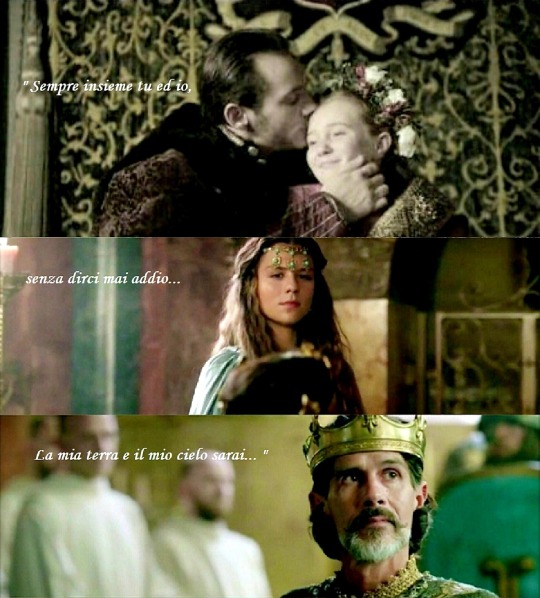

"Always together, you and me,
without ever saying "Goodbye",
You will be my Earth and Sky.
"Go ahead, for every obstacle
there will be,
It won't divide us... _now and never_"
Lyrics from "We are One (Italian version)" from "The lion king 2-Simba's pride"
Am i still obsessively in love with those three characters and their family? YES, I AM. ALWAYS.
#vikings#vikingsedit#vikings rollo#vikings gisla#vikings charles#rollo duke of Normandy#princess Gisla of Western Frankia and duchess of Normandy#emperor Charles#I still love those three and ALWAYS WILL#my otf of this series#family love
13 notes
·
View notes
Text
Medieval Norman Castle A (25mm 1:72 scale Plastic Model)

Medieval Norman Castle A (25mm 1:72 scale Plastic Model)
Details: The Norman Castle A set consists of 13 segments, as follows: 3 corner left towers (short); 1 corner right tower (short); 2 middle towers left; 1 middle tower right; 5 wall segments; and 1 wall gate;
History: The Normans (Norman: Normaunds; French: Normands; Latin: Nortmanni/Normanni) were a population arising in the medieval Duchy of Normandy from the intermingling between Norse Viking settlers and indigenous West Franks and Gallo-Romans. The term is also used to denote emigrants from the duchy who conquered other territories such as England and Sicily. The Norse settlements in West Francia followed a series of raids on the French northern coast mainly from Denmark, although some also sailed from Norway and Sweden. Said settlements were finally legitimized when Rollo, a Scandinavian viking leader, agreed to swear fealty to King Charles III of West Francia following the siege of Chartres in 911 AD. The intermingling in Normandy produced an ethnic and cultural "Norman" identity in the first half of the 10th century, an identity which continued to evolve over the centuries.
The Norman dynasty had a major political, cultural and military impact on medieval Europe and the Near East. The Normans were historically famed for their martial spirit and eventually for their Catholic piety, becoming exponents of the Catholic orthodoxy of the Romance community. The original Norse settlers adopted the Gallo-Romance language of the Frankish land they settled, with their Old Norman dialect becoming known as Norman, Normaund or Norman French, an important literary language which is still spoken today in parts of mainland Normandy (Cotentinais and Cauchois dialects) and the nearby Channel Islands (Jèrriais and Guernésiais). The Duchy of Normandy, which arose from the Treaty of Saint-Clair-sur-Epte, was a great fief of medieval France. The Norman dukes exercised independent control of their holdings in Normandy, while at the same time being vassals owing fealty to the King of France, and under Richard I of Normandy (byname "Richard sans Peur" meaning "Richard the Fearless") the Duchy was forged into a cohesive and formidable principality in feudal tenure. By the end of his reign in 996, the descendants of the Norse settlers "had become not only Christians but in all essentials Frenchmen. They had adopted the French language, French legal ideas, and French social customs, and had practically merged with the Frankish or Gallic population among whom they lived".Between 1066 and 1204, as a result of the Norman conquest of England, most of the kings of England were also dukes of Normandy. In 1204, Philip II of France seized mainland Normandy by force of arms, having earlier declared the Duchy of Normandy to be forfeit to him. It remained disputed territory until the Treaty of Paris of 1259, when the English sovereign ceded his claim to the Duchy, except for the Channel Islands. In the present day, the Channel Islands (the Bailiwick of Guernsey and the Bailiwick of Jersey) are considered to be officially the last remnants of the Duchy of Normandy, and are not part of the United Kingdom but are instead self-governing Crown Dependencies.
The Normans are noted both for their culture, such as their unique Romanesque architecture and musical traditions, and for their significant military accomplishments and innovations. Norman adventurers played a role in founding the Kingdom of Sicily under Roger II after briefly conquering southern Italy and Malta from the Saracens and Byzantines, and an expedition on behalf of their duke, William the Conqueror, led to the Norman conquest of England at the historic Battle of Hastings in 1066. Norman and Anglo-Norman forces contributed to the Iberian Reconquista from the early eleventh to the mid-thirteenth centuries.
Norman cultural and military influence spread from these new European centres to the Crusader states of the Near East, where their prince Bohemond I founded the Principality of Antioch in the Levant, to Scotland and Wales in Great Britain, to Ireland, and to the coasts of north Africa and the Canary Islands. The legacy of the Normans persists today through the regional languages and dialects of France, England, Spain, Quebec and Sicily, and also through the various cultural, judicial, and political arrangements they introduced in their conquered territories.
Sourc: https://en.wikipedia.org/wiki/Normans
Era: Medieval Dark Ages
Description: This 3D Printed model represents an historically accurate facsimile at a scale that one can use for diorama making, model train railroad scenery, war gaming terrain, or creative projects.
Quality: Before selling a 3D print, we make a series of test prints at different model scales to ensure quality, and print reliability. In addition, we print each 3D model using the same resin or PLA plastic brand every time for consistent and repeatable results.
Scale: 25mm figure height (1:72 scale)
Type: 3D Printed Models: unpainted 3D Printed models for you to customize and integrate into your wargame tables, model railroad displays or other artistic and creative projects.
License: This is a licensed 3D Printed Model designed by 3D-Print-Terrain (www.3dprintterrain.de) all rights reserved.
Read the full article
0 notes
Text
A Thing Of Vikings Chapter 129: And A Warm Embrace
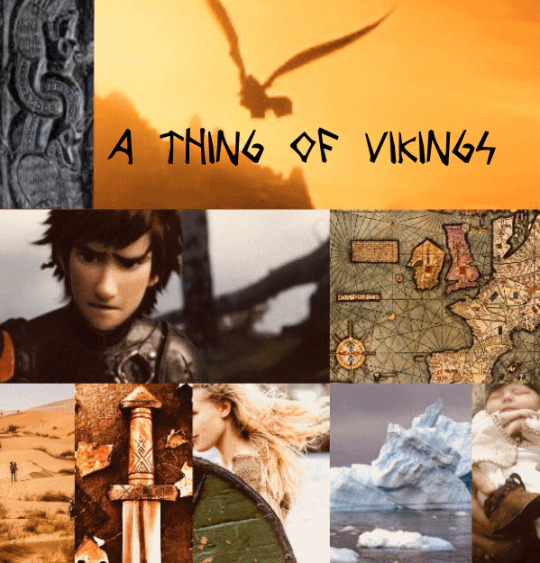
Chapter 129: And A Warm Embrace
During the periods of the Kingdoms of Francia, Brittany (Breton: Breizh), in its position occupying the westernmost peninsula of the region, was regarded as a stubborn outsider—culturally Brythonic Celtic instead of Gallo-Roman, with a different and distinct language, identity, and historical background. Beginning as independent petty kingdoms formed by displaced Celts from the Anglo-Saxon invasion of Britain, Brittany spent the next few centuries fully independent, occasionally joining forces with the Roman Empire against the likes of Attila the Hun, but otherwise being mostly occupied with domestic political matters and associating with their fellow Celtic nations in the Isles, occasionally sending reinforcements to the Cymru, Picts, Kernowyon, and Gaels as they fought against the Anglo-Saxon invaders.
Later, in the 9th century AD, Brittany became a tributary suzerain state to the Carolingian Empire under Emperor Charlemagne, who managed to impose vassalhood on the region, reducing the Breton lords to semi-autonomous status. This did not last long, however, as in the aftermath of Charlemagne’s death, they rebelled against the Carolingians, securing their independence as a unified kingdom of Brittany in 851 AD after defeating Charles the Bald at the Battle of Jengland. From there, they proceeded to expand their kingdom at Francian expense, taking large swaths of territory around the eastern extents of their peninsula, and reaching their greatest territorial extent in 867 AD.
Internal political disputes ensued, stopping the kingdom’s expansion, and rendering it ripe for conquest by Viking raiders in the early 900s; by 919 AD, the entire kingdom was fully occupied by Norsemen, who looted and pillaged many cities and monasteries without facing organized resistance. The region was eventually liberated from the Norse occupiers by Alan “Twistedbeard” II, grandson of King Alan the Great, the prior king of Brittany, between 935 and 939, culminating in an attack on the last Norse stronghold at Trans-la-Fôret by joint Breizh and Frankish forces. Meanwhile, to the neighboring east on what had once been part of the kingdom of Brittany, Rollo the Viking had settled in with his own men, offering allegiance to King Charles the Simple in exchange for claim to what would become known as the Duchy of Normandy.
With his lands in ruin from decades of war and looting, Alan could not hope to restore his prior kingship and likewise made the same decision as Rollo had, offering tribute to King Louis IV of Francia in 942 AD as the Duke of Brittany. This action ended Brittany’s time of independence and politically brought it into the Kingdom of Francia as the Duchy of Brittany. However, the newly-born duchy still had a long independent history and a cultural identity as separate from the rest of the kingdom…
—A History of Old Francia, 1432, Oxford Press
AO3 Link
33 notes
·
View notes
Text
@sonnefuchs I guess I just have to take matters into my own hands.
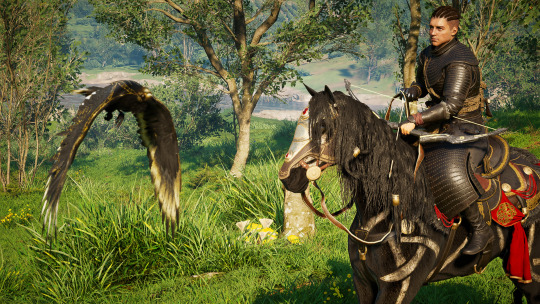
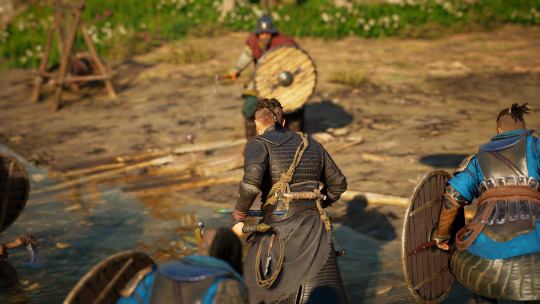
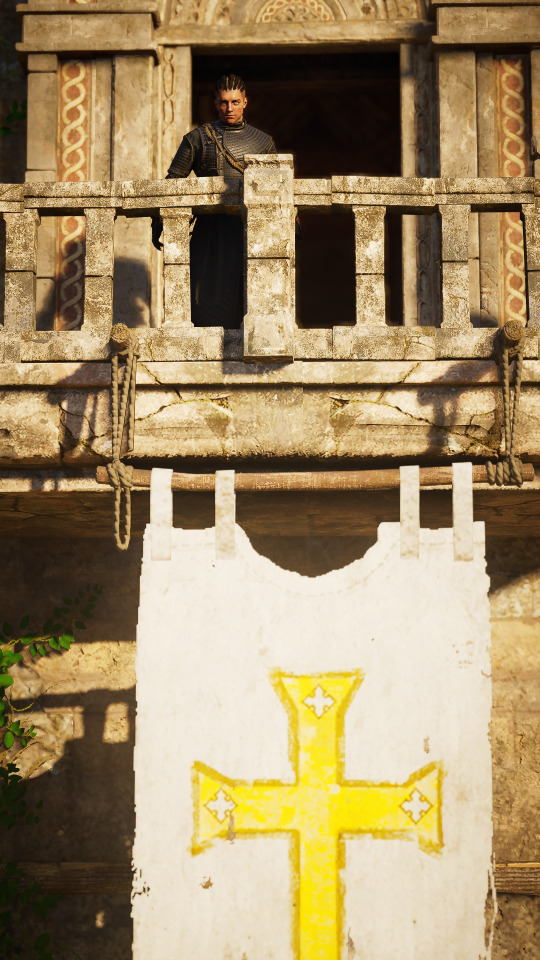


Rollo, Duke of Normandy
#siege of paris#rollo#duke of normandy#Hrólfr#rollon#get it boy#we'll always have paris#pc mods#photo mode#ac valhalla#assassin's creed valhalla#assassin's creed#dlc
24 notes
·
View notes
Photo
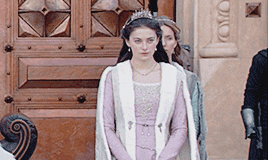
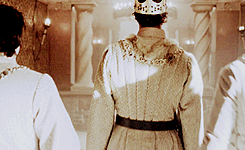
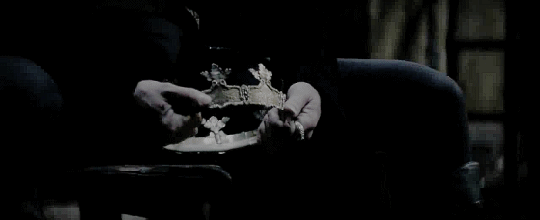

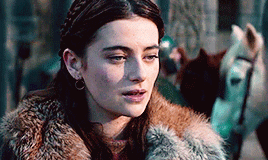
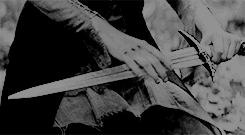
“1002 was a seminal year in the life of the king and his kingdom. The first significant event that took place was the marriage of Aethelred to Emma of Normandy. In 1002, Emma was about seventeen years of age. She was the daughter of Richard I, Duke of Normandy, the place where the Vikings had taken up permanent residence under Duke Rollo not so many years before.
Emma was herself the great-granddaughter of Rollo and the blood of her Viking ancestors still coursed through her veins. The blood relationship was cemented still further by the fact that her mother was Gunnar, a woman of Danish descent. Gunnar was originally Richard’s concubine, though she eventually became his wife in a probable attempt to legitimise their children.
[...] The marriage to Aethelred was a set up to Emma. Allowing for any perceived personal faults and the extent of the challenges facing him, he was still a king, a man who owed allegiance to no other, unlike the dukes of Normandy, who were vassals to the King of France.
This presumably also helped compensate to some extent the substantial age difference between the young bride and her husband, who already had a large number of children from previous relationships. [...] It seems that right from the off it was decided that any offspring from this match with Emma were to take precedence over those previous relationships in matters of succession.
[...] Other later chronicles commented on the match, not always favourably. With the precious gift of hindsight and writing from the safe distance of the middle of the twelfth century, the chronicler Henry of Huntingdon saw the marriage as a turning point in English history:
“I mean that on one side the persecution by the Danes was raging, and on the other the connection with the Normans was growing, so that even if they were to escape the obvious lightning fire of the Danes, valour would not help them to escape the insidious danger from the Normans. This became apparent from subsequent events, since from this union of the English king with the daughter of the Norman duke, the Normans were justified according to the laws of peoples, in both claiming and gaining possession of England.”
[...] The deal was duly struck ahd some of Aethelred’s senior advisers made the crossing to Normandy to escort Emma back to their country, which was to be her home for most of the rest of her days. She was crowned Queen of England soon after her arriving, a coronation of a queen in those days being a rare event (though Elfrida, the king’s mother, had also had one). [...]
[...] Emma was given the Saxon name Aelfgifu (which means ‘noble gift)on her arrival to England. [...] She was granted properties in Oxfordshire, Rutland, Suffolk and Devon as well as ownership of Exeter and Winchester.”
From: “King Cnut and the Viking Conquest of England”, W.B. Bartlett.
#Emma of Normandy#Aelfgifu Regina#Queen Aelfgifu#Queen Emma#House of Normandy#House of Wessex#Aethereld the unready#King Aethereld II#Aethereld II#Anglo-Saxons#medieval#middle ages#vikings#Normandy#rollo of normandy#duke rollo
38 notes
·
View notes